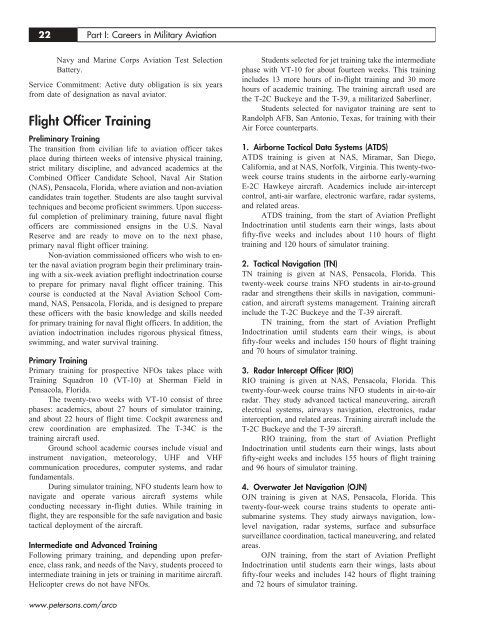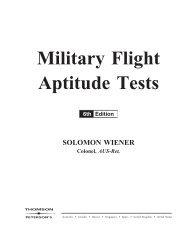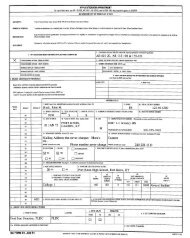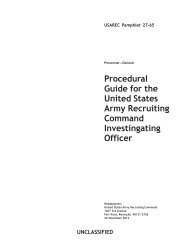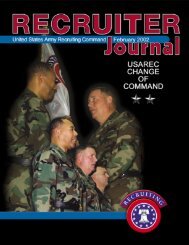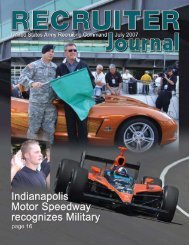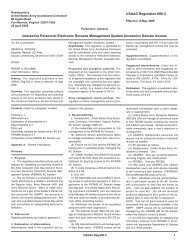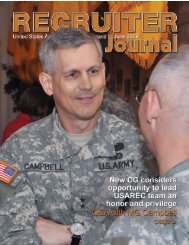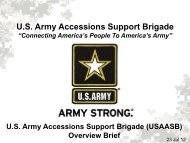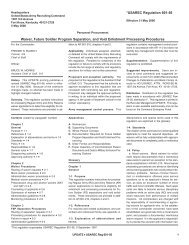Military Flight Aptitude Tests - USAREC - U.S. Army
Military Flight Aptitude Tests - USAREC - U.S. Army
Military Flight Aptitude Tests - USAREC - U.S. Army
You also want an ePaper? Increase the reach of your titles
YUMPU automatically turns print PDFs into web optimized ePapers that Google loves.
22 Part I: Careers in <strong>Military</strong> Aviation<br />
Navy and Marine Corps Aviation Test Selection<br />
Battery.<br />
Service Commitment: Active duty obligation is six years<br />
from date of designation as naval aviator.<br />
<strong>Flight</strong> Officer Training<br />
Preliminary Training<br />
The transition from civilian life to aviation officer takes<br />
place during thirteen weeks of intensive physical training,<br />
strict military discipline, and advanced academics at the<br />
Combined Officer Candidate School, Naval Air Station<br />
(NAS), Pensacola, Florida, where aviation and non-aviation<br />
candidates train together. Students are also taught survival<br />
techniques and become proficient swimmers. Upon successful<br />
completion of preliminary training, future naval flight<br />
officers are commissioned ensigns in the U.S. Naval<br />
Reserve and are ready to move on to the next phase,<br />
primary naval flight officer training.<br />
Non-aviation commissioned officers who wish to enter<br />
the naval aviation program begin their preliminary training<br />
with a six-week aviation preflight indoctrination course<br />
to prepare for primary naval flight officer training. This<br />
course is conducted at the Naval Aviation School Command,<br />
NAS, Pensacola, Florida, and is designed to prepare<br />
these officers with the basic knowledge and skills needed<br />
for primary training for naval flight officers. In addition, the<br />
aviation indoctrination includes rigorous physical fitness,<br />
swimming, and water survival training.<br />
Primary Training<br />
Primary training for prospective NFOs takes place with<br />
Training Squadron 10 (VT-10) at Sherman Field in<br />
Pensacola, Florida.<br />
The twenty-two weeks with VT-10 consist of three<br />
phases: academics, about 27 hours of simulator training,<br />
and about 22 hours of flight time. Cockpit awareness and<br />
crew coordination are emphasized. The T-34C is the<br />
training aircraft used.<br />
Ground school academic courses include visual and<br />
instrument navigation, meteorology, UHF and VHF<br />
communication procedures, computer systems, and radar<br />
fundamentals.<br />
During simulator training, NFO students learn how to<br />
navigate and operate various aircraft systems while<br />
conducting necessary in-flight duties. While training in<br />
flight, they are responsible for the safe navigation and basic<br />
tactical deployment of the aircraft.<br />
Intermediate and Advanced Training<br />
Following primary training, and depending upon preference,<br />
class rank, and needs of the Navy, students proceed to<br />
intermediate training in jets or training in maritime aircraft.<br />
Helicopter crews do not have NFOs.<br />
www.petersons.com/arco<br />
Students selected for jet training take the intermediate<br />
phase with VT-10 for about fourteen weeks. This training<br />
includes 13 more hours of in-flight training and 30 more<br />
hours of academic training. The training aircraft used are<br />
the T-2C Buckeye and the T-39, a militarized Saberliner.<br />
Students selected for navigator training are sent to<br />
Randolph AFB, San Antonio, Texas, for training with their<br />
Air Force counterparts.<br />
1. Airborne Tactical Data Systems (ATDS)<br />
ATDS training is given at NAS, Miramar, San Diego,<br />
California, and at NAS, Norfolk, Virginia. This twenty-twoweek<br />
course trains students in the airborne early-warning<br />
E-2C Hawkeye aircraft. Academics include air-intercept<br />
control, anti-air warfare, electronic warfare, radar systems,<br />
and related areas.<br />
ATDS training, from the start of Aviation Preflight<br />
Indoctrination until students earn their wings, lasts about<br />
fifty-five weeks and includes about 110 hours of flight<br />
training and 120 hours of simulator training.<br />
2. Tactical Navigation (TN)<br />
TN training is given at NAS, Pensacola, Florida. This<br />
twenty-week course trains NFO students in air-to-ground<br />
radar and strengthens their skills in navigation, communication,<br />
and aircraft systems management. Training aircraft<br />
include the T-2C Buckeye and the T-39 aircraft.<br />
TN training, from the start of Aviation Preflight<br />
Indoctrination until students earn their wings, is about<br />
fifty-four weeks and includes 150 hours of flight training<br />
and 70 hours of simulator training.<br />
3. Radar Intercept Officer (RIO)<br />
RIO training is given at NAS, Pensacola, Florida. This<br />
twenty-four-week course trains NFO students in air-to-air<br />
radar. They study advanced tactical maneuvering, aircraft<br />
electrical systems, airways navigation, electronics, radar<br />
interception, and related areas. Training aircraft include the<br />
T-2C Buckeye and the T-39 aircraft.<br />
RIO training, from the start of Aviation Preflight<br />
Indoctrination until students earn their wings, lasts about<br />
fifty-eight weeks and includes 155 hours of flight training<br />
and 96 hours of simulator training.<br />
4. Overwater Jet Navigation (OJN)<br />
OJN training is given at NAS, Pensacola, Florida. This<br />
twenty-four-week course trains students to operate antisubmarine<br />
systems. They study airways navigation, lowlevel<br />
navigation, radar systems, surface and subsurface<br />
surveillance coordination, tactical maneuvering, and related<br />
areas.<br />
OJN training, from the start of Aviation Preflight<br />
Indoctrination until students earn their wings, lasts about<br />
fifty-four weeks and includes 142 hours of flight training<br />
and 72 hours of simulator training.


